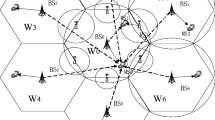Abstract
Relay deployment in orthogonal frequency division multiple access (OFDMA) based cellular networks helps in coverage extension and/or capacity improvement. To quantify capacity improvement, blocking probability of voice call is typically calculated using Erlang B formula. This calculation is based on the assumption that all users require same amount of resources to satisfy their rate requirement. However, in an OFDMA system, each user requires different number of subcarriers to meet its rate requirement. This resource requirement depends on the signal to interference ratio (SIR) experienced by a user. Therefore, the Erlang B formula can not be employed to compute blocking probability in an OFDMA network. In this paper, we determine an analytical expression to compute the blocking probability in a relay based cellular OFDMA network. We determine an expression of the probability distribution of the user’s resource requirement based on its experienced SIR. Then, we classify the users into various classes depending upon their subcarrier requirement. We consider the system to be a multi-dimensional system with different classes and evaluate the blocking probability using the multi-dimensional Erlang loss formulas. This model is useful in the performance evaluation, design, planning of resources and call admission control in a relay based cellular OFDMA networks like long term evolution.










Similar content being viewed by others
Notes
In a practical cellular system, it is ensured that RS does not receive from BS and transmit to MS simultaneously in order to eliminate the relay transmitter causing interference to its own receiver. For example, in LTE, specific subframes known as the Multicast/Broadcast Single Frequency Network (MBSFN) subframes [20] are utilized to create gaps in the RS–MS transmission, during which transmission on only BS–RS link happens. Though we have not specifically considered this scenario, our system model captures such transmission scenario if we consider resource sharing at the subframe level. Note that the analytical results remain unaffected with this consideration.
References
Parkvall, S., Dahlman, E., & Furuskar, A. (2008). LTE-advanced evolving LTE towards IMT-advanced. In Vehicular Technology Conference (pp. 1–5). IEEE.
Cho, J., & Haas, Z. J. (2004). On the throughput enhancement of the downstream channel in cellular radio networks through multihop relaying. IEEE Journal on Selected Areas in Communicatios, 22, 1206–1219.
Lee, J., Park, S., Wang, H., & Hong, D. (2007). QoS-guaranteed transmission scheme selection for OFDMA multi-hop cellular networks. In International Conference on Communications (pp. 4587–4591). IEEE.
Steele, R., Lee, C. C., & Gould, P. (2004). GSM, CDMA one and 3G systems. New York: Wiley.
Kin, K., & Koo, I. (2005). CDMA system capacity engineering. Norwood: Artech House Inc.
Chen, J.-C., & Chen, W.-S. E. (2006). Call blocking probability and bandwidth utilization of OFDM subcarrier allocation in next-generation wireless networks. In IEEE Communication Letters (Vol. 10).
Pla, V., Martinez-Bauset, J., & Casares-Giner, V. (2008). Comments on - call blocking probability and bandwidth utilization of OFDM subcarrier allocation in next-generation wireless networks. In IEEE Communication Letters (Vol. 12).
Paik, C., & Suh, Y. (2011). Generalized queueing model for call blocking probability and resource utilization in OFDM wireless networks. In IEEE Communication Letters (Vol. 15).
Wang, H., Andrews, G., & Iverson, V. (2009). Uplink capacity of 802.16j mobile multihop relay networks with transparent relays. In Globecom (pp. 1–6).
Wang, H., Xiong, C., & Iverson, V. (2009). Uplink capacity of multiclass IEEE 802.16j relay networks with adaptive modulation and coding. In International Conference on Communications.
Joshi, G. (2010). On relay assisted cellular networks. Master’s thesis, Indian Institute of Technology, Bombay.
Glimpson, L. A. (1965). Analysis of mixtures of wide- and narrow-band traffic. IEEE Transactions on Communication Technology, 13, 258–266.
Arthurs, E., & Kaufman, J. S. (1979). Sizing a message store subject to blocking criteria. In 4th International Symposium on Modelling and Performance Evaluation of Computer Systems, Vienna.
Iversen, V. B. (2005). Teletraffic engineering handbook. Com Center, Technical University of Denmark.
Jain, R. B. (2011). On downlink inter cell interference modeling in cellular OFDMA networks. In International Conference on Information Processing (ICIP).
Filho, J. C. S. S., Cardieri, P., & Yacoub, M. D. (2005). Simple accurate lognormal approximation to lognormal sums. Electronics Letters, 41(18), 1016–1017.
Schwartz, S. C., & Yeh, Y. S. (1982). On the distribution function and moments of powers sums with lognormal components. The Bell System Technical Journal, 61(7), 1441–1462.
Kostic, Z., Maric, I., & Wang, X. (2001). Fundamentals of dynamic frequency hopping in cellular systems. IEEE Journal on Selected Areas in Communications, 19(11), 2254–2266.
Bode, M., Sung, K. W., Mudesir, A., & Haa, H. (2009). Analytical SIR for self-organizing wireless networks. EURASIP Journal on Wireless Communications and Networking, p. 8. doi:10.1155/2009/912018
3GPP TS 36.912 v10. (2011). Feasibility study for further advancements for e-utra (lte-advanced).
Kelly, F. (2011). Reversibility and stochastic networks. Cambridge: Cambridge University Press.
3GPP TR 25.814. (2006-06). Physical layer aspects for evolved universal terrestrial radio access (UTRA), (Release 7), V7.0.0.
Khakurel, S., Mehta, M., & Karandikar, A. (2012). Optimal relay placement for coverage extension in LTE-A cellular systems. In National Communications Conference (NCC).
Author information
Authors and Affiliations
Corresponding author
Additional information
This work was performed while the authors—Mahima Mehta and Ranjan Bala Jain were with Department of Electrical Engineering, IIT Bombay.
Rights and permissions
About this article
Cite this article
Mehta, M., Jain, R.B. & Karandikar, A. Analysis of Blocking Probability in a Relay-Based Cellular OFDMA Network. Wireless Pers Commun 84, 2467–2492 (2015). https://doi.org/10.1007/s11277-015-2715-5
Published:
Issue Date:
DOI: https://doi.org/10.1007/s11277-015-2715-5




